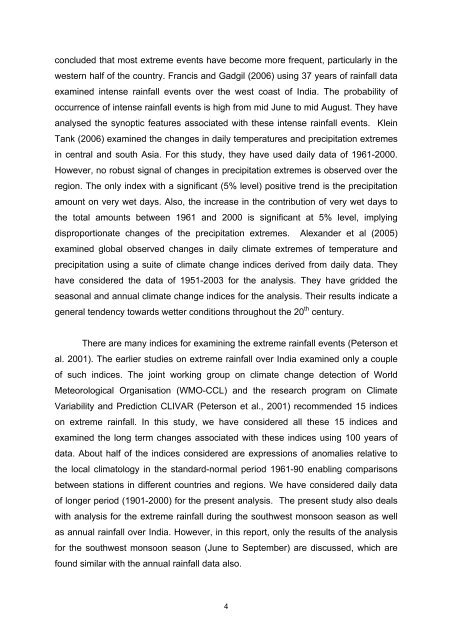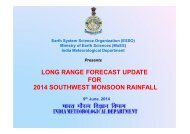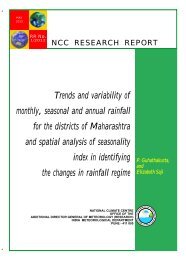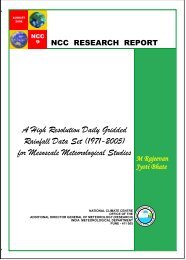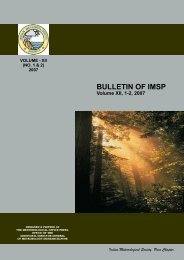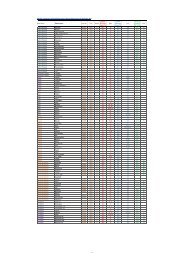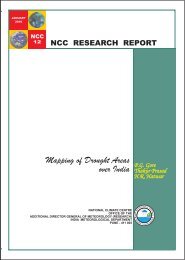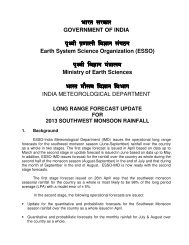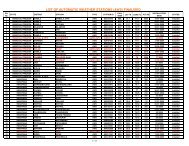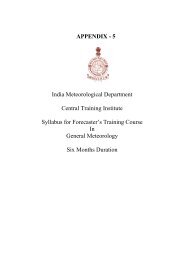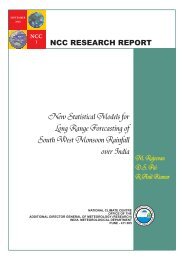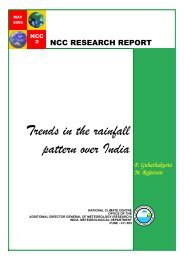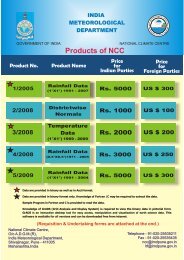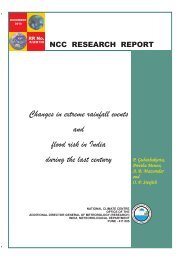Trends in Precipitation Extremes over India - (IMD), Pune
Trends in Precipitation Extremes over India - (IMD), Pune
Trends in Precipitation Extremes over India - (IMD), Pune
You also want an ePaper? Increase the reach of your titles
YUMPU automatically turns print PDFs into web optimized ePapers that Google loves.
concluded that most extreme events have become more frequent, particularly <strong>in</strong> thewestern half of the country. Francis and Gadgil (2006) us<strong>in</strong>g 37 years of ra<strong>in</strong>fall dataexam<strong>in</strong>ed <strong>in</strong>tense ra<strong>in</strong>fall events <strong>over</strong> the west coast of <strong>India</strong>. The probability ofoccurrence of <strong>in</strong>tense ra<strong>in</strong>fall events is high from mid June to mid August. They haveanalysed the synoptic features associated with these <strong>in</strong>tense ra<strong>in</strong>fall events. Kle<strong>in</strong>Tank (2006) exam<strong>in</strong>ed the changes <strong>in</strong> daily temperatures and precipitation extremes<strong>in</strong> central and south Asia. For this study, they have used daily data of 1961-2000.However, no robust signal of changes <strong>in</strong> precipitation extremes is observed <strong>over</strong> theregion. The only <strong>in</strong>dex with a significant (5% level) positive trend is the precipitationamount on very wet days. Also, the <strong>in</strong>crease <strong>in</strong> the contribution of very wet days tothe total amounts between 1961 and 2000 is significant at 5% level, imply<strong>in</strong>gdisproportionate changes of the precipitation extremes. Alexander et al (2005)exam<strong>in</strong>ed global observed changes <strong>in</strong> daily climate extremes of temperature andprecipitation us<strong>in</strong>g a suite of climate change <strong>in</strong>dices derived from daily data. Theyhave considered the data of 1951-2003 for the analysis. They have gridded theseasonal and annual climate change <strong>in</strong>dices for the analysis. Their results <strong>in</strong>dicate ageneral tendency towards wetter conditions throughout the 20 th century.There are many <strong>in</strong>dices for exam<strong>in</strong><strong>in</strong>g the extreme ra<strong>in</strong>fall events (Peterson etal. 2001). The earlier studies on extreme ra<strong>in</strong>fall <strong>over</strong> <strong>India</strong> exam<strong>in</strong>ed only a coupleof such <strong>in</strong>dices. The jo<strong>in</strong>t work<strong>in</strong>g group on climate change detection of WorldMeteorological Organisation (WMO-CCL) and the research program on ClimateVariability and Prediction CLIVAR (Peterson et al., 2001) recommended 15 <strong>in</strong>diceson extreme ra<strong>in</strong>fall. In this study, we have considered all these 15 <strong>in</strong>dices andexam<strong>in</strong>ed the long term changes associated with these <strong>in</strong>dices us<strong>in</strong>g 100 years ofdata. About half of the <strong>in</strong>dices considered are expressions of anomalies relative tothe local climatology <strong>in</strong> the standard-normal period 1961-90 enabl<strong>in</strong>g comparisonsbetween stations <strong>in</strong> different countries and regions. We have considered daily dataof longer period (1901-2000) for the present analysis. The present study also dealswith analysis for the extreme ra<strong>in</strong>fall dur<strong>in</strong>g the southwest monsoon season as wellas annual ra<strong>in</strong>fall <strong>over</strong> <strong>India</strong>. However, <strong>in</strong> this report, only the results of the analysisfor the southwest monsoon season (June to September) are discussed, which arefound similar with the annual ra<strong>in</strong>fall data also.4


